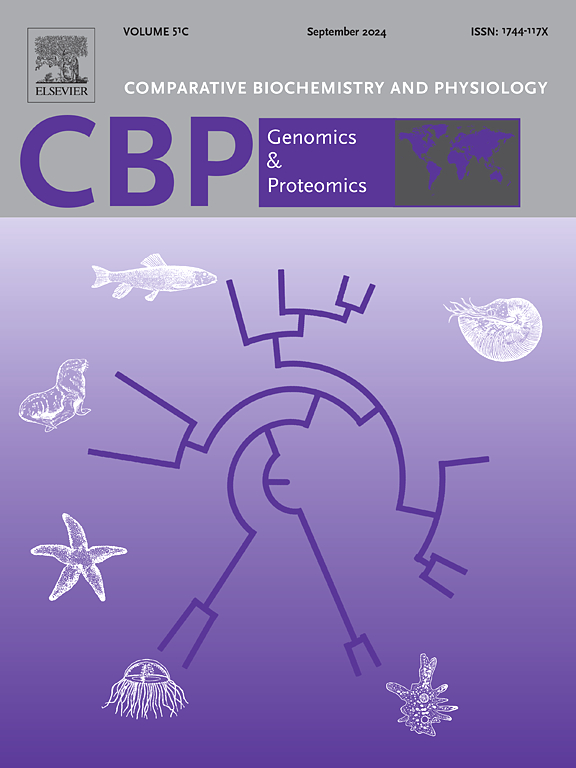An integrated transcriptome, proteome and targeted metabolome analysis reveals genes and steroids related to gonadal development in Ruditapes philippinarum
IF 2.2
2区 生物学
Q4 BIOCHEMISTRY & MOLECULAR BIOLOGY
Comparative Biochemistry and Physiology D-Genomics & Proteomics
Pub Date : 2025-07-22
DOI:10.1016/j.cbd.2025.101587
引用次数: 0
Abstract
Gonadal development in Ruditapes philippinarum involves germ cell formation, sex differentiation, vitellogenesis, and maturation, regulated by complex genes-hormone interactions. To elucidate these mechanisms, multi-omics analyses (transcriptomics, proteomics, and steroid targeted metabolomics) and qPCR were applied to gonads across developmental stages in clams. Differential expression analysis revealed 332 testicular and 560 ovarian genes, alongside 174 testicular and 107 ovarian proteins. Integrated omics identified 12 concordantly annotated gene-protein pairs. Expressed levels for 14 genes (8 transcriptome only, 6 multi-omics) demonstrated that Cyclin B2 (CCNB2), Moloney sarcoma oncogene (MOS), and Glutaminase (GLS) peaked during the maturation stage and significantly declined during the partially spent stage (P < 0.05). These three genes were also more highly expressed in the ovary compared to the testis (P < 0.05). Cell Division Cycle 20 (CDC20), Atrial Natriuretic Peptide Receptor Type A (ANPRA), and Rpsr-1 showed highest levels during both maturation and partially spent stage (P < 0.05), with ANPRA predominantly expressed in the testis, and CDC20 and Rpsr-1 in the ovary; Calmodulin (CALM), Glutamine Synthetase (GLUL), Sushi Domain Containing 2 (SUSD2), Rpsr-2, Rpsr-3, Rpsr-4 and CD151 Molecule (Raph Blood Group) (CD151) attained their highest values in the partially spent stage (P < 0.05), where Rpsr-3, Rpsr-4 and CD151 expressed higher in the testis (P < 0.05), and CALM, GLUL, SUSD2 and Rpsr-2 were more pronounced in the ovary (P < 0.05); Phospholipase A2 Group IVA (PLA2G4) exhibited its highest expression during the growing stage, gradually declining as development progressed, which was significantly higher in the testis than in the ovary (P < 0.05). Targeted metabolomics identified 14 steroids in clam gonads, with five steroids—Pregnenolone, 5α-Pregnane-3,20-dione, 17α-Hydroxypregnenolone, 25-Hydroxycholesterol, and 24-dehydro Cholesterol—elevated during the gonadal growing phase (no sex differences). Intriguingly, 17β-estradiol (typically reported in bivalve gonad development) was undetected. Integrated transcriptomic/proteomic analyses confirmed absence of its synthesis pathway, including key enzymes like cytochrome P450 aromatase (CYP19A1). This study established a multi-omics platform to detect the genes-hormone interactions, and evaluate expression dynamics of 14 key regulators across gonadal stages and sexes in R philippinarum, concurrently evaluating steroid hormones roles. These findings provide valuable resources for further research into the comprehensive regulatory mechanisms governing gonad development in clams.

综合转录组、蛋白质组和靶向代谢组分析揭示了菲律宾Ruditapes philippine arum性腺发育相关的基因和类固醇
菲律宾Ruditapes philippine arum的性腺发育包括生殖细胞形成、性别分化、卵黄形成和成熟,受复杂的基因-激素相互作用调节。为了阐明这些机制,多组学分析(转录组学、蛋白质组学和类固醇靶向代谢组学)和qPCR应用于蛤的不同发育阶段的性腺。差异表达分析显示332个睾丸和560个卵巢基因,以及174个睾丸和107个卵巢蛋白。整合组学鉴定出12对一致注释的基因-蛋白对。14个基因(8个转录组,6个多组)的表达水平表明,细胞周期蛋白B2 (CCNB2)、Moloney肉瘤癌基因(MOS)和谷氨酰胺酶(GLS)在成熟阶段达到峰值,在部分消耗阶段显著下降(P <;0.05)。与睾丸相比,这三个基因在卵巢中的表达也更高(P <;0.05)。细胞分裂周期20 (CDC20)、房利钠肽受体A型(ANPRA)和Rpsr-1在成熟期和部分消耗期均呈最高水平(P <;0.05), ANPRA主要表达于睾丸,CDC20和Rpsr-1主要表达于卵巢;钙调素(CALM)、谷氨酰胺合成酶(GLUL)、含Sushi结构域2 (SUSD2)、Rpsr-2、Rpsr-3、Rpsr-4和CD151分子(Raph血型)(CD151)在部分消耗期达到最高值(P <;0.05),其中Rpsr-3、Rpsr-4和CD151在睾丸中表达较高(P <;0.05),而CALM、GLUL、SUSD2和Rpsr-2在卵巢中更为显著(P <;0.05);磷脂酶A2组IVA (PLA2G4)在生长期表达量最高,随着发育逐渐下降,在睾丸中的表达量显著高于卵巢(P <;0.05)。目标代谢组学鉴定出蛤性腺中的14种类固醇,其中孕烯醇酮、5α-孕烯-3,20-二酮、17α-羟孕烯醇酮、25-羟胆固醇和24-脱氢胆固醇在性腺生长期升高(无性别差异)。有趣的是,17β-雌二醇(通常在双壳性腺发育中报道)未被检测到。综合转录组学/蛋白质组学分析证实其合成途径缺失,包括细胞色素P450芳香化酶(CYP19A1)等关键酶。本研究建立了多组学平台,检测基因与激素的相互作用,评估14个关键调控因子在菲律宾海蒿不同性腺阶段和性别间的表达动态,同时评估类固醇激素的作用。这些发现为进一步研究蛤性腺发育的综合调控机制提供了宝贵的资源。
本文章由计算机程序翻译,如有差异,请以英文原文为准。
求助全文
约1分钟内获得全文
求助全文
来源期刊
CiteScore
5.10
自引率
3.30%
发文量
69
审稿时长
33 days
期刊介绍:
Comparative Biochemistry & Physiology (CBP) publishes papers in comparative, environmental and evolutionary physiology.
Part D: Genomics and Proteomics (CBPD), focuses on “omics” approaches to physiology, including comparative and functional genomics, metagenomics, transcriptomics, proteomics, metabolomics, and lipidomics. Most studies employ “omics” and/or system biology to test specific hypotheses about molecular and biochemical mechanisms underlying physiological responses to the environment. We encourage papers that address fundamental questions in comparative physiology and biochemistry rather than studies with a focus that is purely technical, methodological or descriptive in nature.

 求助内容:
求助内容: 应助结果提醒方式:
应助结果提醒方式:


